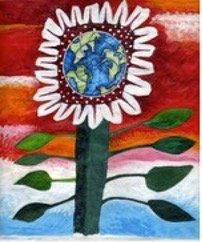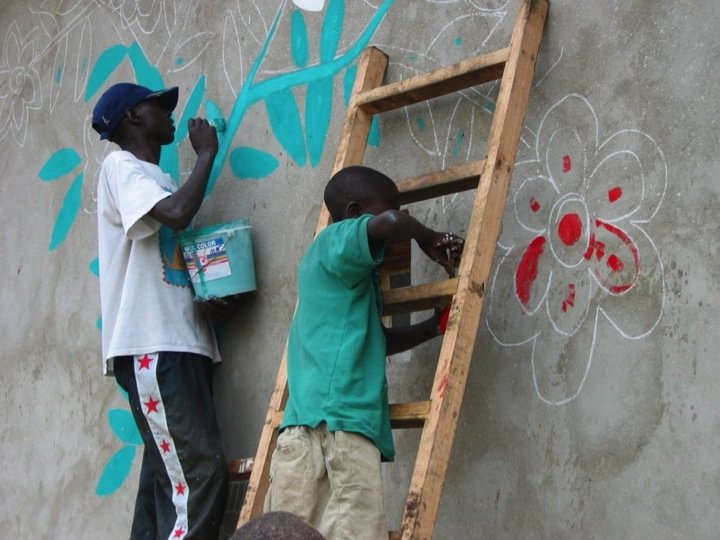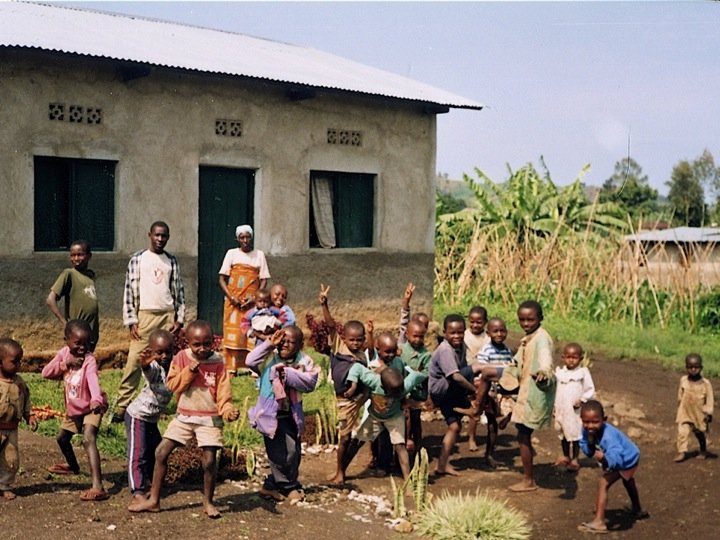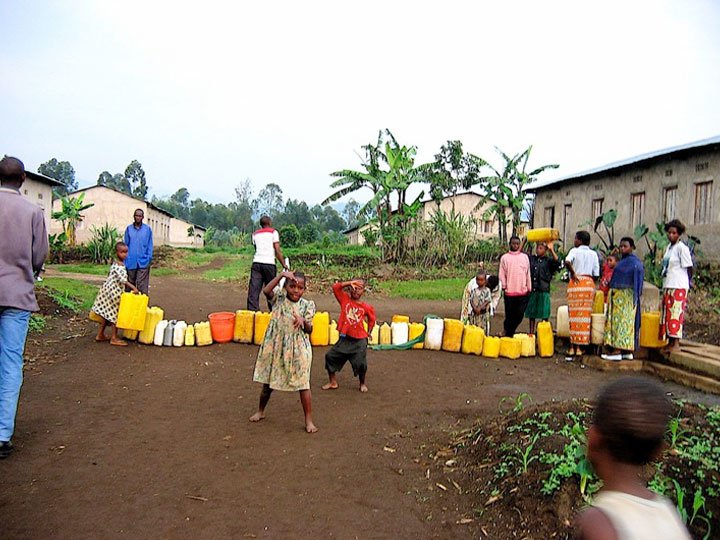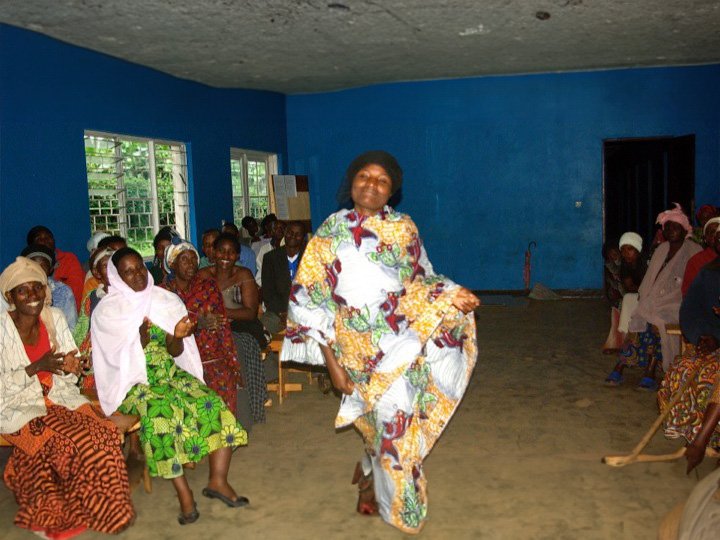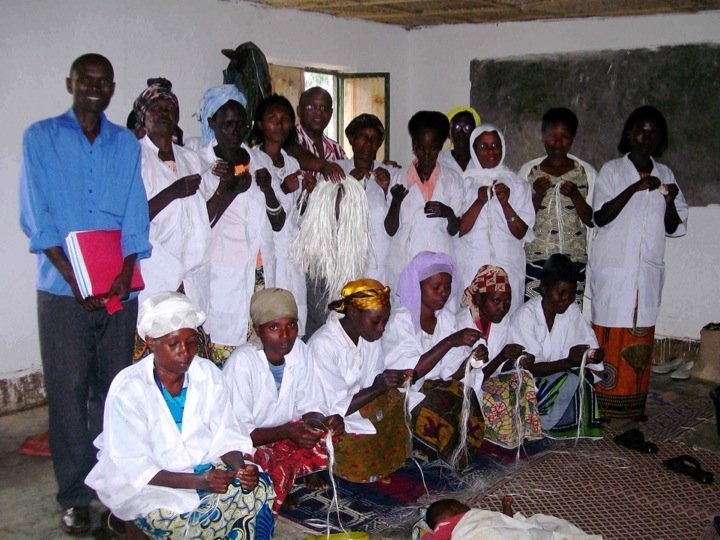Rugerero Survivors Village
Gisenyi, Rwanda
(2004 – Present)
(Left) “No room to sit” by Chris Noble, (right) at community celebration in 2008
Rwanda is a beautiful country filled with green hills and mountains. Bordering Congo in Western Rwanda, Gisenyi, a beautiful city on Lake Kivu, is a three hour drive from Kigali, the capital city.
When my host Jean Bosco Musana took me to visit the Survivors’ Village in Rugerero, I was delighted to see the greenery and open space. But the silence and the grey cement-blocked houses with panel-less windows made the village feel desolate and forlorn. We knocked on the door of Mama Emma, the only adult I saw on that day. Elderly and thin, she greeted us graciously but with silence.
I visited her every time I returned to the village; I don’t remember that she ever talked much. I found out that during the genocide, Mama Emma lost all of the family members on her father’s side. Ever since, she rarely spoke.
The Survivors’ Village contains 100 families, comprised mostly of widows, orphaned youth and very young children. After the genocide, the government quickly erected simple structures to house the poorest. There was no electricity, running water, or facilities in these houses. People were thrown together; they did not know nor trust their neighbors. No one smiled or laughed except for the very young. Having lost their homes and family members and with no income or job opportunities, villagers suffered in isolation. I sensed a pained stillness in the village during my first visit in July of 2004.
For healing to occur, we needed to address both the past — the dark, evil, and destructive force manifested in the 1994 genocide, and the present -– the survivors and their upcoming families. The building of the Rugerero Genocide Memorial helped the survivors to honor their dead and to heal. The transformation of the Survivors’ Village, which unfolded through a ten-year period of infrastructure building and skill training, empowered the villagers to create self- sustaining work and to prosper.
This comprehensive transformation project included: installing rain harvesting devices for the villagers, building vented sanitation facilities for all families, creating a basic health system, launching a micro-lending program, setting up goat and chicken rearing, and sponsoring multi-year, multi-faceted skill training activities in sewing, basket weaving, sunflower seed oil production, charcoal production from leaves, solar energy panel assembly, and art and sculpture making.
Grass-roots driven and community lead, this extensive community building project benefitted greatly from the expertise of many local and international professionals including the Rwanda Red Cross, Engineers Without Borders, Thomas Jefferson University in Philadelphia, University of Florida in Gainesville, Skyheat Associates in Maine, and more. We greatly appreciate the support from many visionary funders and private donors that helped to make this project a success.
The Rwanda Healing Project demonstrates the power of art in transforming brokenness into wholeness, and desolation into vitality and hope. Art is not merely a luxury to be acquired, it is essential to the well being of the human soul. Creating art in despairing places is like making a fire in the darkness of a winter’s night. It illuminates, beckons, and brings hope. Art lays the foundation for the possibility of profound social change, and artists can play a central role in that change.
How to communicate the sense of hope and possibilities with people who speak a different language, live in a different cultural system, and have experienced the trauma of genocide? Start with children and through art. Take action to beautify their environment.
How to communicate the sense of hope and possibilities with people who speak a different language, live in a different cultural system, and have experienced the trauma of genocide? Start with children and through art. Take action to beautify their environment.
Honor children’s work by turning them into public art that celebrates local artistic sensitivity.
A two-inch drawing by a child transformed into a public mural, expressing the desire for milk and abundance.
Villagers painted their dreams and aspirations on the exterior walls of their homes
To create resources for the villagers, Barefoot Artists launched a goat rearing program with the gifts received from friends in Philadelphia in 2006.
Rugerero Survivors Village of 100 families before the transformation, mostly widows and young children, with no income, no job opportunities, no electricity, and few options for the future. Mama Emma, center, lost all the family members on her father’s side. She rarely spoke since the genocide.
There are two faucets in the village for all the families. Sometimes when the water system is shut down for repair, villagers have to walk three miles to a polluted river for water. It causes tremendous hardship for the elderly. Most the villagers suffer from parasites, malnutrition, and malaria.
The testimony of a proud mother – She bought a cow with her micro-loan. She sells milk and her children drink milk. She is paying back her loan and has money to pay her children’s school fees.
The village now has cows. It resulted from the beneficial government and Barefoot Artists’ micro-loan programs.
Rwanda has two raining seasons. Barefoot Artists sponsored the installation of rain water harvest tank for the 100 families in the village in 2007. An engineer from Kigali and six masons from the survivors village completed the task. Using the solution produced by Population Services International (PSI), villagers now have safe water for washing and drinking.
Working with faculty and students from the JeffHealth program of Thomas Jefferson Medical University in Philadelphia, 2007.
Working with villagers, Engineers Without Borders constructed of the well-designed and vented sanitation facility for each family. This is a huge improvement of the quality of life in the village. 2010
Responding to the request from a group of elder women in the village, Barefoot Artists sponsored a multi-year basket weaving program to preserve and pass on the making of this traditional art from.
Barefoot Artists sponsored a year long training of sewing for young orphaned women. Upon their graduation, each participant was provided with a sewing machine to continue her work. Ecstatic, the group broke out dancing and singing, “Bye Bye to poverty.” 2008
Since the spring of 2009, Barefoot Artists has been working with solar engineer Richard Komp of Skyheat Associates to bring solar energy to Rugerero Survivors Village. He trained 30 some villagers the skill of building cell phone chargers and PV modules. 10 members were so inspired that they formed the Radiant Horizon Cooperative with the intention to bring solar energy to all of the households in the village and to neighboring communities.
Each year, community celebrated their accomplishments in a colorful procession. Different groups proudly displayed their products, solar panels, sunflower seed oil, charcoal pieces, and many more.
Beautiful masks carved by young sculptors. Their teacher Jules Hagumimana proudly walked by their side.
Rejoice for the hope of the future.
